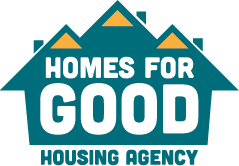If you are using a Section 8 voucher, you should check with your landlord.
If you live in a Homes for Good-owned unit, please fill out a pet application. You must wait for approval before you bring the pet home. If you want a service/companion animal, your doctor will need to fill out a Reasonable Accommodation (RA) saying why it is medically necessary for you to have the pet. Companion-only pets require a $150 deposit. RA/service pets have no deposit but must follow the same rules.
DownloadsIf you have the birth, adoption or court awarded custody of a minor to add to your household or you want to add someone to your household, please contact our Service Center at (541) 682-3755
When you add an adult to your household, that adult can have rights to the housing subsidy should the family decide to separate. For example, a Head of Household who adds a Co-head to their family cannot at a later date solely decide the co-head can no longer use the housing subsidy. A housing subsidy cannot be split into two housing subsidies should the family decide to separate.
If the family breakup results from an occurrence of domestic violence, dating violence, sexual assault, or stalking, Homes for Good must ensure that the victim retains assistance.
If a court determines the disposition of property between members of the assisted family, Homes for Good is bound by the court’s determination of which family members continue to receive assistance.
If the family cannot decide who will retain the housing subsidy Homes for Good is required to decide. In making its determination, Homes for Good will take into consideration the following factors: (1) the interest of any minor children, including custody arrangements; (2) the interest of any ill, elderly, or disabled family members; (3) the interest of any family member who is the victim of domestic violence, dating violence, sexual assault, or stalking, including a family member who was forced to leave an assisted unit as a result of such actual or threatened abuse; (4) any possible risks to family members as a result of criminal activity; and (5) the recommendations of social service professionals.
